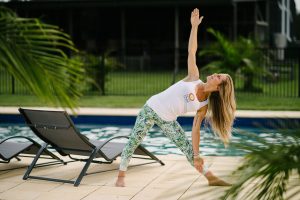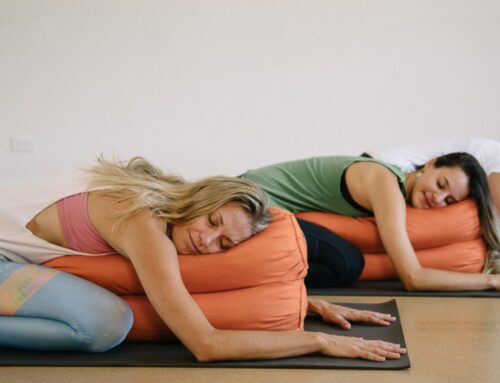Andrew Olson, senior Byron Yoga Centre trainer and practicing physiotherapist, gives us an insight in to one of the topics he covers on the Practical Anatomy Training 14-17 October.
What is Hypermobility? Is this a bad thing?
Defining what we mean by hypermobility is a goodplace to start. People with hypermobility can be split into two groups. The first group can be classified as having ‘Generalised Joint Hypermobility’ and this is when a person has an increased amount of movement around their joints when compared to the general population, but this increased movement does not cause them any pain.
The second group can be classified as having ‘Joint Hypermobility Syndrome’ which is characterised by an increased joint mobility with associated chronic pain, fatigue, abdominal pain and headaches. These groups are assessed by using written questionnaires and physical testing protocols designed to determine if the movement around your joints is greater than the average person and whether this excessive movement creates pain in your body.
If you are diagnosed with generalised joint hypermobility this is not necessarily a problem. A study by Kumar & Lenert in 2017, reported that some people with general joint hypermobility actually have an advantage in some athletic endeavours such as dance and gymnastics. There are only a small group of people with generalised joint hypermobility that progress to having joint hypermobility syndrome. It is thought that around 3% of the population may suffer from joint hypermobility syndrome and unfortunately many of these people may be undiagnosed due to a lack of awareness and challenges in differential diagnosis from other conditions.
Does practicing yoga with hypermobile joints cause us damage?

So what does all this mean for our yoga practice? Should a student with generalised joint hypermobility, or joint hypermobility syndrome practice differently than other students? And are these students at a greater risk of damaging the structures of their joints due to this increased movement?
There is some evidence to suggest that people with joint hypermobility have an increased likelihood of ligament, cartilage and meniscal injuries (Smith et al. 2014). However this is not conclusive as not everyone who is hypermobile will develop these joint related injuries.
So what can we do to make sure that those of us who practice yoga and who may be hypermobile don’t injure themselves while practicing? The key is to focus on building strength through your movement. And this strength must be built throughout the entire range of our movement. This means if we are hypermobile we need to strengthen our muscles into this excessive range of motion.
This may sound a little counter intuitive however developing strength right to the end of our available range will help us control movements into this area of hypermobility and therefore protect the joint structures with this increased strength of our muscular system.
So should we lock our joints in yoga or not?
Back to the original question, should we lock our joints while practicing yoga asana? Let’s take a quick look at what is happening when we lock our joints.
Generally we lock our joints when the muscle group on one side of the joint is very active and the muscle group on the other side is more relaxed. For example let’s look at the knee joint in trikonasana or triangle pose. Our front leg in this posture has the knee extended. And the muscle group that extends the knee is the quadriceps at the front of the thigh. If we only contract our quadriceps in this posture the knee joint will become as extended as it possibly can and if we are hypermobile this could be into that zone of hypermobility.
Often teachers will encourage students to microbend their knee in trikonasana to avoid this zone of hypermobility. Microbending the knee will engage the hamstring muscle group which strengthens the back of the knee. If the quadriceps and the hamstrings are activated together this is called a co-contraction and provides a lot of stability around a joint. This co-contraction can be very helpful for people who suffer from pain or poor movement control at the end of their available range as this will increase their muscle engagement and reduce loading onto the structures of the joint.
However, if we never allow our joints to move into areas of hypermobility we will never give our body the chance to become strong in this range of movement. And for those of us with hypermobile joints this increased range of movement is a very important zone to be strong in.
My main focus when teaching such postures is not about the position of the joint (locked or microbent) but rather the amount of muscular activation you have while in this position. Whether that muscular activation comes primarily from one muscle group and the knee is locked or two muscle groups and the knee is microbent the important thing is that there is a good amount of muscle activation to take the load of the posture and support the structures of the joint. The thing we definitely want to avoid is not having any muscular activation and ‘hanging in our joints’ which will transfer all of the weight of the posture onto the structures around the joint and almost certainly lead to pain and injury.
Conclusion
As usual once we start looking into the nuances of the body the answer to whether we should lock our joints in yoga is… it depends. If you feel like locking your knee in trikonasana by forcefully activating your quadriceps is a strong and stable position and you don’t feel any pain, then maybe this is a good option for you.
However, if this feels painful or awkward then activating your hamstring muscles to microbend into a cocontraction could work better for your body. The important thing is to continually check in with how your joints are feeling and if there is any discomfort your best bet is to increase the amount of muscle activation around that joint to maintain a safe and strong practice.
References
Kumar, B. and P. Lenert. 2017. Joint hypermobility syndrome: recognizing a commonly overlooked cause of chronic pain. American Journal of Medicine. 130(6):640-647. https://doi.org/10.1016/j.amjmed.2017.02.013
Toby O. Smith, Victoria Easton, Holly Bacon, Emma Jerman, Kate Armon, Fiona Poland, Alex J. Macgregor, The relationship between benign joint hypermobility syndrome and psychological distress: a systematic review and meta-analysis, Rheumatology, Volume 53, Issue 1, January 2014, Pages 114–122, https://doi.org/10.1093/rheumatology/ket317
